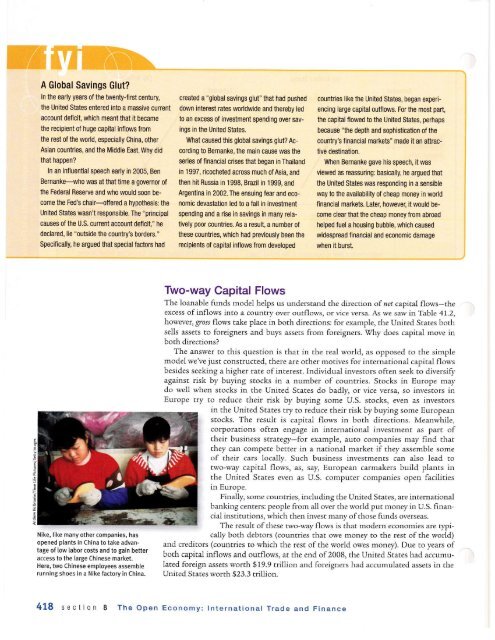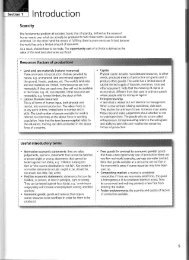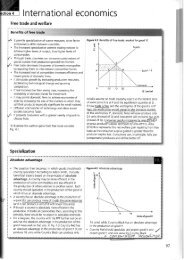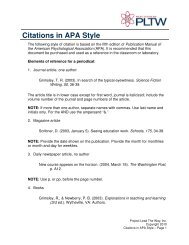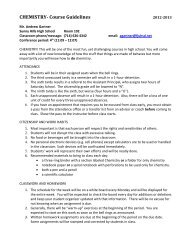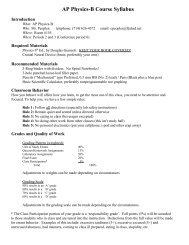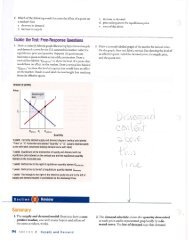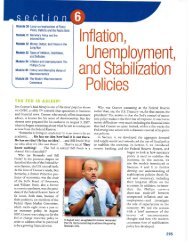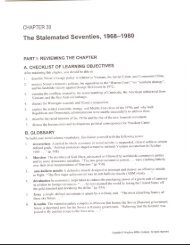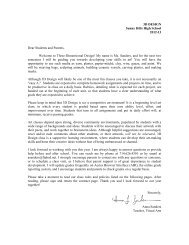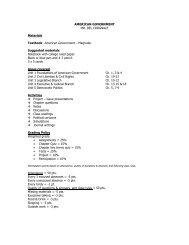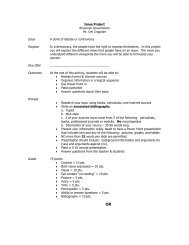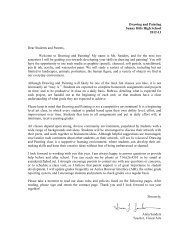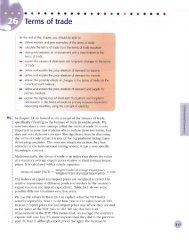AP Econ Module 41 Capital Flows Balance Payments - Sunny Hills ...
AP Econ Module 41 Capital Flows Balance Payments - Sunny Hills ...
AP Econ Module 41 Capital Flows Balance Payments - Sunny Hills ...
You also want an ePaper? Increase the reach of your titles
YUMPU automatically turns print PDFs into web optimized ePapers that Google loves.
A Global Savings Glut?<br />
ln the early years 0f the twenty-first century,<br />
the United States entered into a massive current<br />
account delicit, which meant that it became<br />
the recipient of huge capital inllows lrom<br />
the rest 0fthe world, especially China,other<br />
Asian countries, and the Middle East. Why did<br />
that happen?<br />
ln an influential speech early in 2005, Ben<br />
Bernanke-who was at thal time a governor of<br />
the Federal Reserve and who would soon be-<br />
come the Fedb chair---{ffered a hypothesis;the<br />
United States wasn't responsible, The "principal<br />
causes of the U.S. current account deficit," he<br />
declared, lie "outside the country's borders."<br />
Specifically, he argued that special factors had<br />
Nike, like many other companies, has<br />
opened plants in China to take advan'<br />
tage of low [abor costs and to gain better<br />
access to the large Chinese market.<br />
Here, two Chjnese employees assemble<br />
running shoes in a Nike factory in China.<br />
created a "globalsavings glut" that had pushed<br />
down interest rates worldwide and thereby led<br />
to an excess of investment spending over sav-<br />
ings in the United States,<br />
What caused this global savings glut? Ac-<br />
cording to Bernanke, the main cause was the<br />
series of financialcrises that began in Thajland<br />
in 1997, ricocheted across much ofAsia, and<br />
then hit Russia in 1998, Brazil in 1999, and<br />
Argentina in 2002. The ensuing fear and eco-<br />
nomic devastation led to a fall in investment<br />
spending and a rise in savings in many rela-<br />
tively poor countries. As a result, a number ol<br />
these countries, which had previously been the<br />
recipients of capital inflows from developed<br />
countries like the United States, began experi-<br />
encing large capital outflows. For the most part,<br />
the capital flowed t0 the lJnited States, perhaps<br />
because "the depth and sophistication of the<br />
counlry's financial markets" made it an attrac-<br />
tive destination.<br />
When Bernanke gave his speech, it was<br />
viewed as reassuring: basically, he argued that<br />
the United Slates was responding in a sensible<br />
way t0 the availability 0f cheap money in world<br />
financial markets. Later, however, it would be-<br />
come clear that the cheap money from abroad<br />
helped luel a housing bubble, which caused<br />
widespread financial and economic damage<br />
when it burst,<br />
Two-way <strong>Capital</strong> <strong>Flows</strong><br />
The loanable funds model helps us understand the direcrion ofrer capital flows the<br />
etcess ofinflows into a country over outflows, or vice versa. As we saw in Table <strong>41</strong>.2,<br />
however, grors flows take place in both directions: for example, the United States both<br />
sells assets to foreigners and buys assets from foreigners. Why does capital move in<br />
both directions?<br />
The answer to this question is that in the real world, as opposed to the simple<br />
model we've just conscructed, there are other motives for international capital flows<br />
besides seeking a higher rate ofinterest. lndividual investors often seek ro diversify<br />
against risk by buying stocks in a number of countries. Srocks in Europe may<br />
do well when srocks in rhe United Scates do badly, or vice versa, so investors in<br />
Europe try to reduce their risk by buying some U.S, stocks, even as invescors<br />
in the United States try to reduce their risk by buying some European<br />
stocks. The lesult is capital flows in both directions. Meanwhile,<br />
corporations often engage in international invesrment as part of<br />
their business strategy-for example, auto companies may Find that<br />
they can compete better in a national market iF they assemble some<br />
of their cars locally. Such business investments can also lead to<br />
two-way capital flows, as, say, European carmakers build plants in<br />
the United States even as U.S. computer companies open facilities<br />
in Europe.<br />
Finally, sorne countries, including the United States, are international<br />
banking centers: people from all over the world put money in U.S. financial<br />
institutions, which then invest many ofthose funds overseas.<br />
The result ofthese two-way flows is that modern economies are typically<br />
both debtors (countties that owe money to rhe rest of the world)<br />
and creditors (countries to which the rest of the world owes money). Due to years of<br />
both capital inflows and outflou,s, ar the end of2008, the United States had accumu-<br />
Iated foreign assets worth $19.9 trillion and foleigners had accumulated assets in the<br />
United States worth 523.3 rrillion.<br />
<strong>41</strong>8 s e c t i0 n I The Open <strong>Econ</strong>omy: lnternationat Trade and Finance


